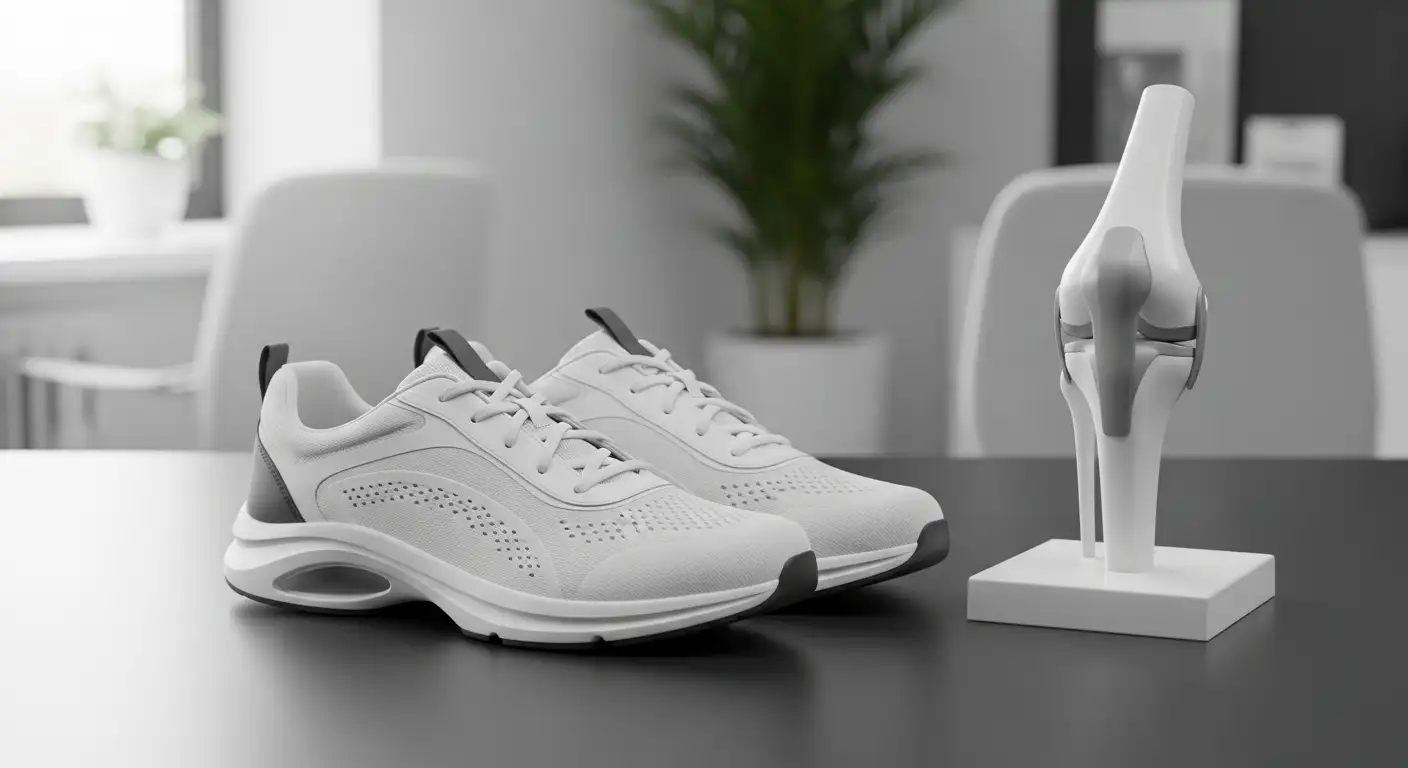Understanding Knee Pain
Knee pain is a common issue that can affect individuals of all ages. It can be disruptive and affect the ability to perform daily activities such as walking, standing, and lifting. The causes for this discomfort are varied and understanding them is crucial in determining the best knee pain when walking treatment options.
Causes of Knee Pain
Knee pain can occur due to a variety of factors such as arthritis, injury, and overuse. It's often associated with old age, but given the current sedentary lifestyles, young people are also experiencing knee pain.

Knee pain can also be a result of the aging process and continual wear and stress on the knee joint. This includes conditions like arthritis, or from sudden movements that strain the knee. Common knee problems include sprained or strained knee ligaments and/or muscles, torn cartilage, tendonitis, and arthritis.
Arthritis can lead to the degenerative process where the cartilage in the joint wears away. Osteoarthritis, affecting mostly middle-aged and older people, is the most common type of arthritis that affects the knee. Rheumatoid arthritis, a condition that causes inflammation and destruction of knee cartilage, can also affect the knees, often at an earlier age than osteoarthritis [2].
Knee pain is often associated with general wear and tear from daily activities like walking, bending, standing, and lifting. Athletes who run or play sports that involve jumping or quick pivoting are also more likely to experience knee pain and problems [2].
Symptoms and Diagnosis
The symptoms of knee pain can vary greatly depending on the cause. It may present as a constant ache, a sharp, shooting pain when using the knee, or a dull, burning discomfort. The pain might be temporary, or it might persist or get worse over time. Other symptoms can include swelling and stiffness, redness and warmth to touch, weakness or instability, popping or crunching noises, or inability to fully straighten the knee.
To diagnose the cause of knee pain, medical professionals may use various diagnostic tests. These tests may include X-rays, MRIs, CT scans, arthroscopy, and radionuclide bone scans. These tests allow them to assess damage, disease, or degeneration in the knee joint [2].
Seek medical attention if knee pain persists all the time, or if it is severe enough to disrupt your daily routine or activities. In cases of trauma like a car accident or severe fall, inability to move the knee or leg, or suspected broken bones, it is advisable to go to the emergency room or call emergency services immediately.
Non-Surgical Treatment Options
Non-surgical treatment options for knee pain when walking are often the first line of defense before considering more invasive procedures. These methods are designed to alleviate pain, improve mobility, and enhance quality of life. They include over-the-counter medications, physical therapy, and lifestyle modifications.
Over-the-Counter Medications
Over-the-counter pain relievers, such as Nonsteroidal Anti-Inflammatory Drugs (NSAIDs) or acetaminophen, are commonly recommended for managing knee pain when walking. These medications help to reduce inflammation and alleviate pain, making it easier for individuals to perform daily tasks and engage in physical therapy exercises. It's always important to follow the recommended dosage and consult with a healthcare provider if the pain persists or worsens [3].
Physical Therapy
Physical therapy is a crucial aspect of knee pain treatment. It involves various techniques, such as strengthening and stretching exercises, that can help reduce pain and improve flexibility. Physical therapists may also utilize therapies like ice packs, heat therapy, ultrasound, or electrical stimulation to further aid in pain relief and recovery. These approaches aim to enhance the knee's strength and stability, promoting better mobility and reducing the risk of future injuries.
Lifestyle Modifications
Lifestyle modifications, such as weight loss and wearing supportive footwear, can significantly impact the management of knee pain when walking. Reducing extra weight can alleviate pressure on the knees and reduce pain. Supportive, well-fitted footwear can help maintain proper leg alignment and balance, reducing strain on the knee joint. Additionally, the RICE method - rest, ice, compression, and elevation - can be useful for at-home care to prevent worsening of the injury, reduce swelling, and relieve pain [5].
In conclusion, non-surgical treatment options for knee pain when walking can be highly effective. However, it's essential to consult with a healthcare provider to determine the best approach based on individual needs and conditions.
Surgical Treatment Options
When the knee pain becomes severe or doesn't respond to non-surgical treatment options, surgical intervention may be considered. Two common surgical procedures for addressing knee pain include knee arthroscopy and knee replacement surgery.
Knee Arthroscopy
Knee arthroscopy is a minimally invasive surgical procedure that allows doctors to visualize and repair internal knee damage. During this procedure, a small camera (arthroscope) is inserted into the knee joint, providing a clear view of the inside of the knee. Surgical instruments are then inserted through other small incisions to repair or remove damaged tissues. This technique allows for a quicker recovery and less post-operative pain compared to traditional open surgery [2].
Knee arthroscopy might be recommended for treating various knee conditions such as torn meniscus, torn or damaged anterior or posterior cruciate ligament, inflamed or damaged synovium, misaligned patella, or loose bodies in the knee joint. It's important to note that knee arthroscopy is typically considered for individuals who have not found relief from knee pain through non-surgical treatments, such as physical therapy or medications, and whose knee pain is significantly affecting their quality of life [3].
Knee Replacement Surgery
When initial treatments fail to provide relief, and X-rays reveal joint destruction, knee replacement surgery may be recommended. Also known as total knee joint replacement, this procedure involves removing the damaged parts of the knee joint and replacing them with an artificial implant.
The type of implant used and the extent of the knee replacement (total or partial) will depend on the severity and type of knee damage. The main goal of knee replacement surgery is to restore function to the knee and alleviate pain that has not been controlled by other treatments.
Despite being a major surgery, knee replacement has a high success rate in improving mobility and quality of life. However, as with any surgery, it carries risks and potential complications, such as infection or blood clots, so it's important for individuals to discuss these factors and their personal health circumstances with their healthcare provider when considering knee replacement surgery.
Both knee arthroscopy and knee replacement surgery offer potential benefits for individuals suffering from knee pain when walking. The choice between these surgical knee pain when walking treatment options will depend on the specific condition causing the pain, the patient's overall health, and their personal preferences.
Alternative Therapies
Along with traditional medical treatments, alternative therapies can also play a significant role in managing and relieving knee pain when walking. These therapies, which include acupuncture, massage therapy, biofeedback, and relaxation techniques, offer an additional dimension to knee pain treatment options, often providing much-needed relief for those dealing with chronic pain.
Acupuncture and Massage Therapy
Acupuncture, an ancient practice that involves inserting thin needles into specific points on the body, can be used to manage chronic knee pain. The process is believed to stimulate the body's natural healing processes and promote pain relief.
Massage therapy, on the other hand, involves applying pressure and manipulating the muscles and soft tissues in and around the knee. This can improve circulation, reduce muscle tension, improve joint flexibility, and promote relaxation. Joint mobilization and manipulation, manual therapy techniques often incorporated in massage, have been found to provide short-term pain relief for patients with knee osteoarthritis [6].
Biofeedback and Relaxation Techniques
Biofeedback is a technique that helps individuals gain control over their body's functions, such as heart rate or muscle tension. During a biofeedback session, a therapist attaches electrodes to the skin and uses these devices to monitor different bodily functions. The goal is to make subtle changes, like relaxing certain muscles, to achieve relief from knee pain.
Relaxation techniques, on the other hand, are methods that assist in reducing stress and promoting relaxation. These techniques, including deep breathing, meditation, and progressive muscle relaxation, can help manage chronic knee pain by reducing muscle tension and stress, both of which can exacerbate pain.
Physical therapists may also incorporate other modalities like electrotherapy and ultrasound when treating knee pain secondary to osteoarthritis. These modalities can help in pain management and improving function in patients with knee osteoarthritis.
Alternative therapies offer a holistic approach to knee pain treatment, addressing not just the physical pain, but also the emotional and psychological aspects of dealing with chronic pain. While these therapies can provide relief, they should be used in conjunction with traditional medical treatments for maximum benefit. As always, it's important to discuss these options with your healthcare provider to determine the best course of treatment for your specific needs.
Prevention and Management
Prevention is the first line of defense in managing knee pain when walking. Implementing key lifestyle changes and safety measures can significantly reduce the occurrence and intensity of knee pain.
Exercise and Strength Training
Regular exercise and strength training can enhance flexibility, lower inflammation levels, and alleviate knee pain. Engaging in short bursts of exercise, such as for 10 minutes twice a day, is recommended. Low-impact workouts that can be safely done at home, such as yoga or swimming, are ideal for strengthening the knee joint and promoting overall health [1].
For runners experiencing knee pain, adjusting training routines to incorporate strength training can significantly help alleviate discomfort. The use of proper footwear is also crucial to support the feet and knees during exercise.
Weight Management
Maintaining a healthy weight is an essential part of reducing knee pain when walking. Excess weight puts additional stress on knee joints, leading to pain. Lifestyle changes such as a balanced diet and regular exercise can help manage weight and alleviate pressure on the knees [1].
Safety Tips and Precautions
Safety during physical activities is crucial to prevent knee pain. Following safety tips like using proper techniques, wearing appropriate gear, and warming up can help reduce the risk of knee injuries. Also, proper warm-up and cool-down routines before and after exercises are essential to prevent injuries, improve performance, and prevent strains on the joints.
Adapting your home environment by placing commonly used items where they are easily accessible without crouching down can also help alleviate knee pain. For instance, storing frequently used pots and pans on a countertop rack and cleaning supplies on a higher shelf can be beneficial.
When experiencing moderate pain, resting the knees is essential, as it indicates the body needs rest. It is crucial to avoid overexertion during exercises and take time off your feet at least twice a day [8].
By implementing these preventive measures and management techniques, the impact of knee pain when walking can be significantly reduced, paving the way for more pain-free steps in the future.
References
[1]: https://regenorthosport.in/blog/preventing-knee-pain-exercises-and-lifestyle-changes-that-can-help/
[2]: https://www.hopkinsmedicine.org/health/conditions-and-diseases/knee-pain-and-problems
[3]: https://my.clevelandclinic.org/health/symptoms/21207-knee-pain
[4]: https://www.mayoclinic.org/diseases-conditions/knee-pain/diagnosis-treatment/drc-20350855
[5]: https://docs.github.com/en/get-started/writing-on-github/working-with-advanced-formatting/creating-and-highlighting-code-blocks
[6]: https://pubmed.ncbi.nlm.nih.gov/23213666/
[7]: https://www.mayoclinic.org/diseases-conditions/knee-pain/symptoms-causes/syc-20350849
[8]: https://www.thespineandsportscenter.com/blog/5-daily-habits-that-can-help-alleviate-your-knee-pain





